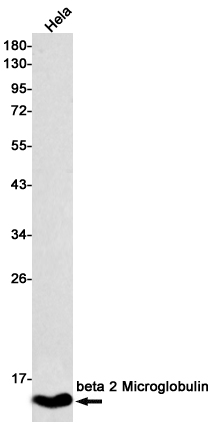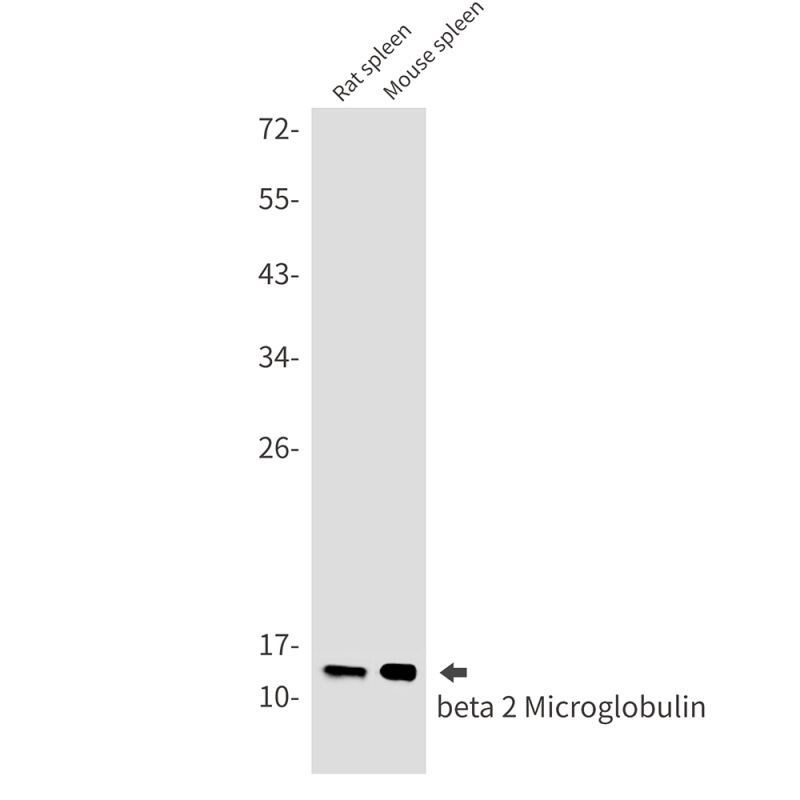

| WB | 咨询技术 | Human,Mouse,Rat |
| IF | 1/20 | Human,Mouse,Rat |
| IHC | 咨询技术 | Human,Mouse,Rat |
| ICC | 技术咨询 | Human,Mouse,Rat |
| FCM | 咨询技术 | Human,Mouse,Rat |
| Elisa | 咨询技术 | Human,Mouse,Rat |
| Aliases | B2MG; Beta 2 microglobin; Beta 2 microglobulin; Beta-2-microglobulin form pI 5.3; CDABP0092; Hdcma22p |
| Entrez GeneID | 567 |
| WB Predicted band size | Calculated MW: 14 kDa; Observed MW: 14 kDa |
| Host/Isotype | Rabbit IgG |
| Antibody Type | Primary antibody |
| Storage | Store at 4°C short term. Aliquot and store at -20°C long term. Avoid freeze/thaw cycles. |
| Species Reactivity | Human,Mouse,Rat |
| Immunogen | A synthetic peptide of human beta 2 Microglobulin |
| Formulation | Purified antibody in TBS with 0.05% sodium azide,0.05%BSA and 50% glycerol. |
+ +
以下是关于beta-2 Microglobulin(β2M)抗体的3篇代表性文献摘要:
---
1. **文献名称**:*Beta 2-Microglobulin: A New Form of Amyloid Protein Associated with Chronic Hemodialysis*
**作者**:Gejyo, F., et al. (1985)
**摘要**:首次发现β2M在长期血液透析患者中形成淀粉样沉积,揭示了其作为透析相关淀粉样变性的关键病理标志物,并推动了对β2M抗体在临床检测中的应用研究。
---
2. **文献名称**:*Development of a Sensitive ELISA for Beta-2-Microglobulin in Serum*
**作者**:Hyltoft Petersen, P., et al. (1988)
**摘要**:描述了一种高灵敏度的ELISA检测方法,利用特异性β2M抗体定量血清中的β2M水平,为肾功能评估和肿瘤免疫监测提供了可靠工具。
---
3. **文献名称**:*Beta-2-Microglobulin as a Diagnostic Marker in Inflammatory Diseases*
**作者**:Fukatsu, A., et al. (1991)
**摘要**:探讨了β2M抗体在炎症性疾病(如类风湿性关节炎)中的应用,证明血清β2M水平与疾病活动性相关,支持其作为炎症和免疫激活的生物标志物。
---
如需更具体领域的研究(如抗体开发或结构分析),可进一步补充说明。
Beta-2 microglobulin (B2M) is a small, non-glycosylated protein (11-12 kDa) that forms the invariant light chain of major histocompatibility complex (MHC) class I molecules, essential for antigen presentation to T-cells. It is constitutively expressed on nearly all nucleated cells and circulates freely in bodily fluids. B2M levels in serum or urine serve as biomarkers for various conditions, including renal dysfunction, inflammatory diseases, and certain cancers like multiple myeloma.
Antibodies targeting B2M are critical tools in research and diagnostics. Polyclonal and monoclonal anti-B2M antibodies are widely used to study MHC class I complex assembly, immune regulation, and cellular turnover. They enable detection of B2M via techniques such as Western blotting, immunohistochemistry (IHC), flow cytometry, and ELISA. In clinical settings, these antibodies aid in diagnosing renal tubular disorders (e.g., elevated urinary B2M indicates impaired proximal tubule reabsorption) and monitoring dialysis efficacy.
B2M’s role in amyloidosis, where it aggregates into fibrils in dialysis-related amyloidosis, has also driven antibody development for pathological studies. Additionally, B2M antibodies are employed in cancer research to explore MHC class I downregulation, a common immune evasion mechanism. Their specificity and versatility make B2M antibodies indispensable in both basic immunology and translational medicine.
×